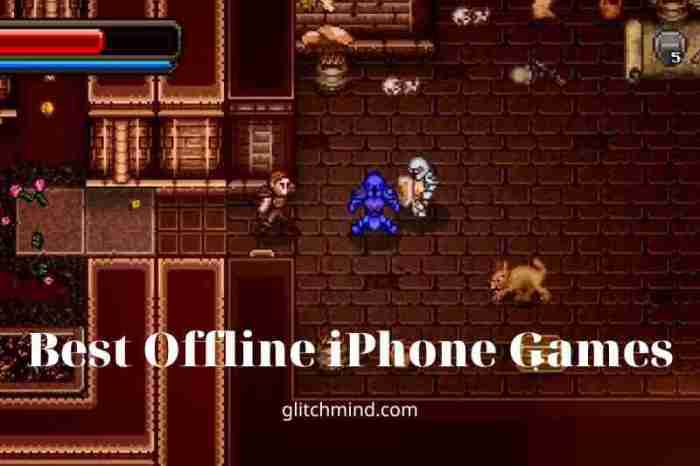Great iPhone Games A Deep Dive
The iPhone app store is a treasure trove of gaming experiences, but navigating the vast landscape of titles can be daunting. From casual puzzles to immersive RPGs, the sheer variety of genres available on the platform is astounding. This analysis delves into the key elements that define great iPhone games, exploring popular genres, core mechanics, monetization strategies, and the vital role of visual design.
This exploration will categorize popular genres by gameplay style, examining the unique characteristics and mechanics that distinguish each. We’ll also dissect the monetization strategies employed by developers, highlighting the trade-offs between different approaches. Furthermore, the critical role of visual appeal and design in capturing player attention and enhancing the overall experience will be thoroughly analyzed.
Popular Genres of iPhone Games

iPhone gaming has exploded in popularity, encompassing a diverse range of genres. This variety caters to diverse player preferences, from strategic puzzle games to action-packed adventures. Understanding the dominant genres provides valuable insight into the landscape of mobile gaming.
Top 5 Popular Genres
The most prevalent genres on the iPhone platform are characterized by distinct gameplay styles and mechanics. These genres attract millions of players globally.
- Casual Games: These games emphasize simplicity and ease of play, often featuring repetitive, accessible gameplay loops. Examples include match-three puzzles, time management, and farm-simulations. The core mechanics usually revolve around simple actions, quick reactions, and strategic resource management.
- Action Games: Action games focus on fast-paced gameplay and reflexes, typically involving combat, exploration, and challenging environments. Core mechanics often center around precise controls, weapon mastery, and strategic combat.
- Puzzle Games: Puzzle games challenge players to solve intricate problems using logic and strategy. These games can range from simple match-three puzzles to complex logic problems, and the core mechanics vary widely, depending on the game.
- Role-Playing Games (RPGs): RPGs offer players the opportunity to build characters, level up, and explore vast worlds. Core mechanics often involve character customization, combat systems, and strategic decision-making.
- Simulation Games: Simulation games replicate real-world experiences, allowing players to engage in activities like managing businesses, running farms, or exploring historical settings. Core mechanics often involve resource management, production, and strategic decision-making.
Monetization Strategies

| Genre | Gameplay Style | Monetization | Example Games |
|---|---|---|---|
| Casual | Simple, repetitive gameplay loops | In-app purchases (IAP) of virtual currency, cosmetic items, or premium features. Frequent advertisements. | Candy Crush, FarmVille, Subway Surfers |
| Action | Fast-paced, reflex-based gameplay | IAP for in-game currency, character upgrades, or cosmetic items. Ad-based monetization. | Asphalt 9, PUBG Mobile, Call of Duty Mobile |
| Puzzle | Logic-based, problem-solving gameplay | IAP for hints, skips, or additional content. Free-to-play with advertisements. | 2048, Sudoku, Monument Valley |
| RPG | Character building, exploration, combat | IAP for in-game currency, character upgrades, or cosmetic items. Free-to-play with advertisements. | Genshin Impact, Final Fantasy Brave Exvius, Pokémon Go |
| Simulation | Real-world experience replication | IAP for premium features or content. Free-to-play with advertisements. | City Skylines, Stardew Valley, Farming Simulator |
Key Features & Mechanics
iPhone games excel through intuitive controls, engaging stories, and stunning visuals. The core gameplay mechanics vary greatly, but often include intuitive touch controls and simple gestures. Many games integrate compelling narratives and intricate story lines to enhance user engagement.
| Feature | Description | Examples |
|---|---|---|
| Intuitive Controls | Simple touch controls and gestures for seamless gameplay. | Most iPhone games |
| Engaging Stories | Compelling narratives and storylines that draw players in. | Many RPGs, Adventure games |
| Stunning Visuals | High-quality graphics and animations that enhance the player experience. | Many mobile games, especially action and simulation titles |
Monetization Models
| Monetization Model | Description | Pros | Cons |
|---|---|---|---|
| In-App Purchases (IAP) | Players pay for in-game items, currency, or premium features. | Potentially high revenue, recurring revenue. | Can create pay-to-win scenarios, may alienate free-to-play players. |
| Ad-based Monetization | Displays advertisements to generate revenue. | Low barrier to entry for developers, wide reach. | Can negatively impact user experience, may be perceived as intrusive. |
Visual Appeal & Design
Visual design is crucial for mobile games, often influencing player engagement and perception of quality. Modern iPhone games leverage stylized visuals to create immersive worlds and engaging experiences. This often includes realistic or stylized rendering to suit the genre and theme.
| Art Style | Description | Example Games | Player Impact |
|---|---|---|---|
| Cartoonish | Bright, colorful, and simplified visuals | Many casual games, some RPGs | Creates a friendly and approachable atmosphere |
| Realistic | Detailed, lifelike visuals | Action games, simulations | Creates a sense of immersion and realism |
Game Development Considerations
Developing successful iPhone games requires meticulous attention to technical optimization and user experience. Developers must balance visual appeal with performance, ensuring a smooth and engaging gameplay experience on diverse devices. This involves considerations such as device compatibility and performance across varying screen sizes.
